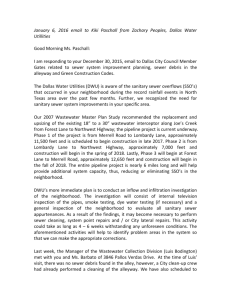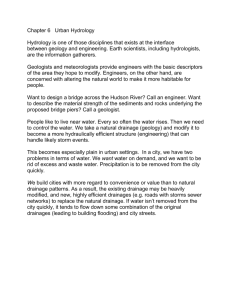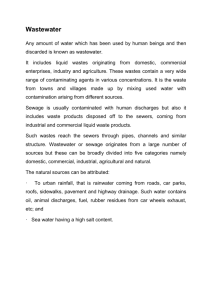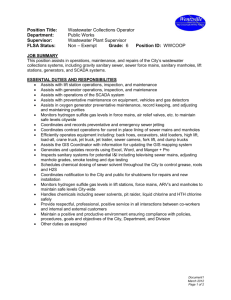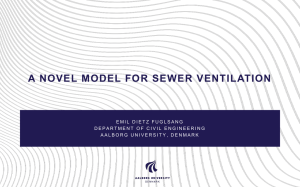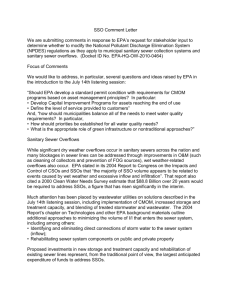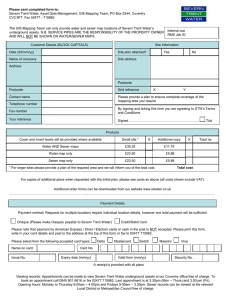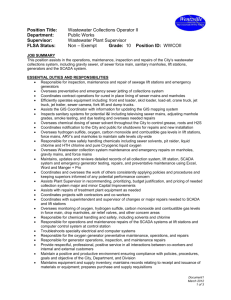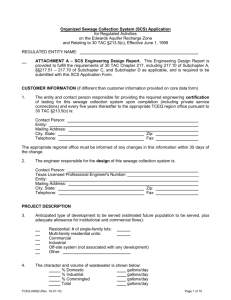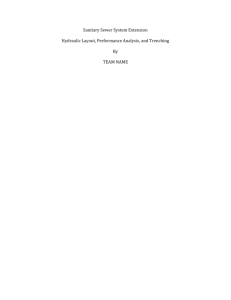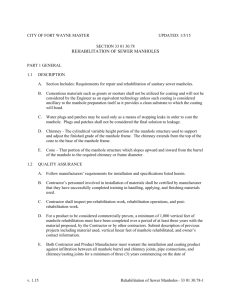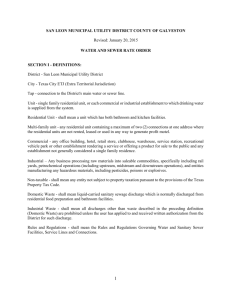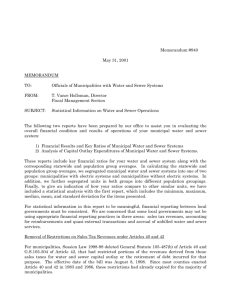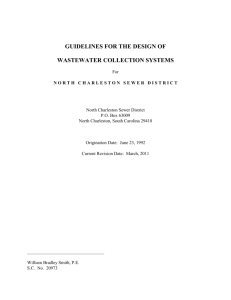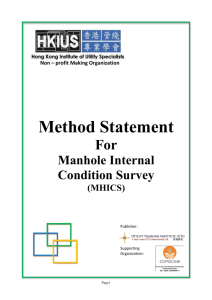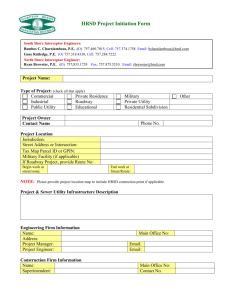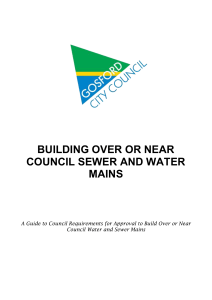WWT 180 Wastewater Collection
advertisement
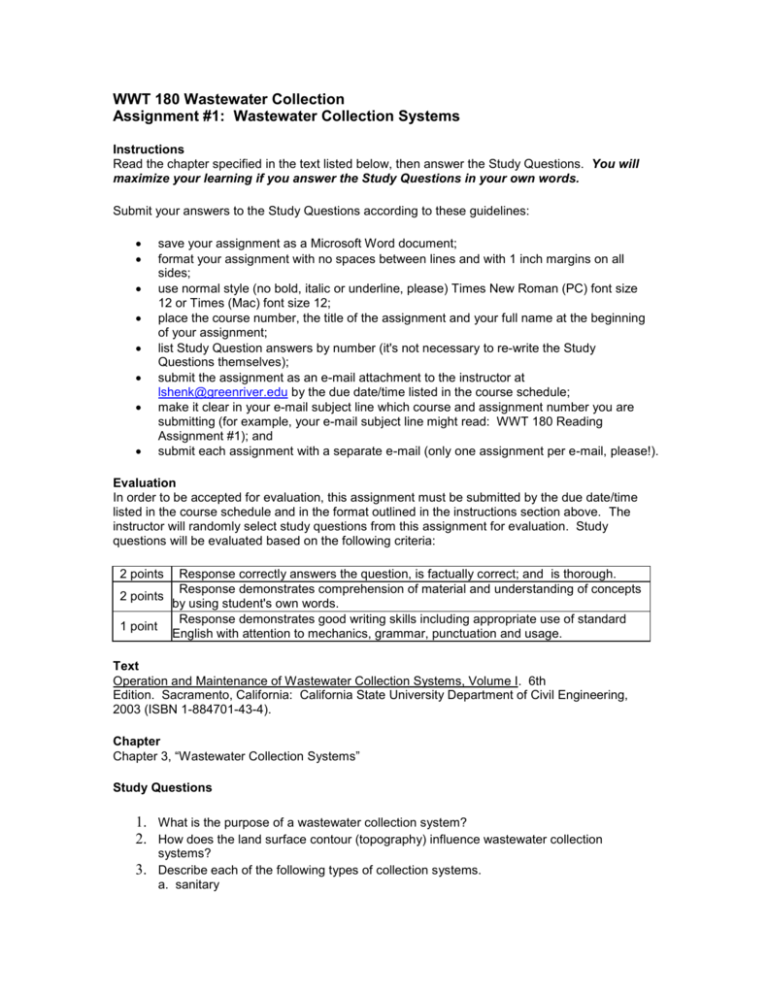
WWT 180 Wastewater Collection Assignment #1: Wastewater Collection Systems Instructions Read the chapter specified in the text listed below, then answer the Study Questions. You will maximize your learning if you answer the Study Questions in your own words. Submit your answers to the Study Questions according to these guidelines: save your assignment as a Microsoft Word document; format your assignment with no spaces between lines and with 1 inch margins on all sides; use normal style (no bold, italic or underline, please) Times New Roman (PC) font size 12 or Times (Mac) font size 12; place the course number, the title of the assignment and your full name at the beginning of your assignment; list Study Question answers by number (it's not necessary to re-write the Study Questions themselves); submit the assignment as an e-mail attachment to the instructor at lshenk@greenriver.edu by the due date/time listed in the course schedule; make it clear in your e-mail subject line which course and assignment number you are submitting (for example, your e-mail subject line might read: WWT 180 Reading Assignment #1); and submit each assignment with a separate e-mail (only one assignment per e-mail, please!). Evaluation In order to be accepted for evaluation, this assignment must be submitted by the due date/time listed in the course schedule and in the format outlined in the instructions section above. The instructor will randomly select study questions from this assignment for evaluation. Study questions will be evaluated based on the following criteria: 2 points Response correctly answers the question, is factually correct; and is thorough. Response demonstrates comprehension of material and understanding of concepts 2 points by using student's own words. Response demonstrates good writing skills including appropriate use of standard 1 point English with attention to mechanics, grammar, punctuation and usage. Text Operation and Maintenance of Wastewater Collection Systems, Volume I. 6th Edition. Sacramento, California: California State University Department of Civil Engineering, 2003 (ISBN 1-884701-43-4). Chapter Chapter 3, “Wastewater Collection Systems” Study Questions 1. What is the purpose of a wastewater collection system? 2. How does the land surface contour (topography) influence wastewater collection 3. systems? Describe each of the following types of collection systems. a. sanitary 4. 5. 6. 7. 8. 9. 10. 11. 12. 13. 14. 15. 16. 17. 18. 19. 20. 21. 22. 23. 24. 25. 26. 27. 28. 29. 30. 31. 32. 33. 34. 35. 36. 37. b. storm water c. combined Define the following terms. a. infiltration b. inflow Describe factors that influence the design period of a wastewater collection system. List factors that are used to calculate design flows for a particular design period. What are typical per capita flows from residential sources? Why do infiltration design allowances vary by city in Table 3.2? The depth of flow in a 16-inch diameter sewer is 4 inches. Determine the cross-sectional area of the flow. How are actual wastewater velocities measured in the field? A stick travels the 350 feet between two manholes in 2 minutes and 40 seconds. Estimate the velocity in the sewer. The velocity in a 24-inch sewer line is 1.5 ft/sec and the flow cross-sectional area is 0.4127 ft2. Determine the rate of flow in ft3/sec. Convert a flow of 0.60 ft3/sec to million gallons per day (MGD). Describe the rationale for the flow variations in dry weather wastewater flow from a typical community. Why does the section on Gravity Collection System begin with a description of a building sewer? What are alternatives for where a property owner’s responsibility ends and a utility’s responsibility begins? Why might the issue of responsibility for a building sewer be important? What minimum size (diameter) pipe should be used for a service lateral? Describe at least two locations where a building sewer cleanout might be installed. What is a building sewer cleanout used for? In Figure 3.2, is the main sewer located under the property owner’s yard, the sidewalk or the street? Why are ground elevation contour lines included in Figure 3.3? Why is the treatment plant in Figure 3.3 located near the river? When is a lift station used? Describe the conditions in which a low pressure or vacuum collection system would be installed instead of a gravity collection system. What are some advantages of installing low pressure systems instead of gravity systems? Describe why a vacuum system might be more difficult to operate and maintain than a low pressure system. Which of the three types of backflow preventers described in the text has the most advantages? Why? Describe the possible locations for a building sewer cleanout. Which of the four types of building sewer connections (taps) described in the text has the most advantages? Why? What is the purpose of a manhole? What is the typical distance between manholes in a straight run of sewer line? Where are manholes placed? When is a drop manhole used? Describe the options for steps in a manhole. What is the typical diameter of a manhole lid or opening? How might manhole elevation be adjusted after additional street paving is added? 38. What is the purpose of the eccentric cone section of a manhole? 39. What is the typical diameter of a manhole barrel? 40. Describe the shape of a manhole floor. 41. How are junction structures different from interconnector sewers? 42. Describe an example of where an inverted siphon might be installed. 43. Describe why a flow regulator might be installed in a wastewater collection system. 44. What factors determine the slope of a sewer line? 45. Why is the velocity of wastewater in a sewer line important? 46. What factors determine the size of a sewer line? 47. Where are sewer lines generally located? 48. What factors determine the depth of a sewer line? 49. List potential advantages and limitations for each of the following pipe materials. 50. 51. a. asbestos-cement (ACP) b. cast iron (CIP) c. ductile iron (DIP) d. acrynonitrile butadiene styrene (ABS) c. polyvinyl chloride (PVC) Describe how each of the following types of pipe joints are constructed. a. Push-on bell and spigot with gasket b. Push-on bell and spigot with mechanical joint c. Coupling with gaskets d. Coupling with gaskets e. Rubber coupling with compression bands What materials might be used for manholes?
